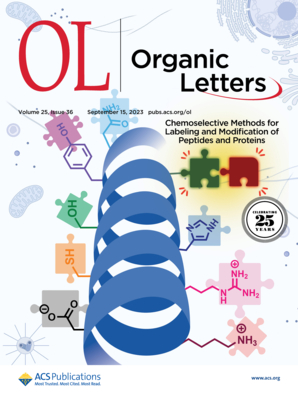hfip介导的双环[1.1.0]丁烷与氢过氧化物的开环非对映选择性接触过氧环丁烷
IF 5
1区 化学
Q1 CHEMISTRY, ORGANIC
引用次数: 0
摘要
在六氟异丙醇(HFIP)中,双环[1.1.0]丁烷(BCBs)以氢过氧化物为亲核试剂,在温和条件下进行无过渡金属开环反应,可在较宽的范围内非对映选择性合成过氧环丁烷。初步的机理实验,包括密度泛函数理论研究,提供了对反应机理和立体化学结果的深入了解,从而强调了HFIP在激活BCB进行易亲核加成中的独特作用。本文章由计算机程序翻译,如有差异,请以英文原文为准。
![HFIP-Mediated Ring Opening of Bicyclo[1.1.0]butanes with Hydroperoxides for Diastereoselective Access to Peroxycyclobutanes](https://img.booksci.cn/booksciimg/2025-9/104309385881790002185.jpg)
![HFIP-Mediated Ring Opening of Bicyclo[1.1.0]butanes with Hydroperoxides for Diastereoselective Access to Peroxycyclobutanes](https://img.booksci.cn/booksciimg/2025-9/2025090810375624942091.png)
HFIP-Mediated Ring Opening of Bicyclo[1.1.0]butanes with Hydroperoxides for Diastereoselective Access to Peroxycyclobutanes
A transition-metal-free ring opening of bicyclo[1.1.0]butanes (BCBs) using hydroperoxides as nucleophiles in hexafluoroisopropanol (HFIP) resulting in the diastereoselective synthesis of peroxycyclobutanes under mild conditions with a broad scope is demonstrated. Preliminary mechanistic experiments, including density functional theory studies, provide insight into the mechanism and stereochemical outcome of the reaction, thus underscoring the unique role of HFIP in activating BCB for facile nucleophilic addition.
求助全文
通过发布文献求助,成功后即可免费获取论文全文。
去求助
来源期刊

Organic Letters
化学-有机化学
CiteScore
9.30
自引率
11.50%
发文量
1607
审稿时长
1.5 months
期刊介绍:
Organic Letters invites original reports of fundamental research in all branches of the theory and practice of organic, physical organic, organometallic,medicinal, and bioorganic chemistry. Organic Letters provides rapid disclosure of the key elements of significant studies that are of interest to a large portion of the organic community. In selecting manuscripts for publication, the Editors place emphasis on the originality, quality and wide interest of the work. Authors should provide enough background information to place the new disclosure in context and to justify the rapid publication format. Back-to-back Letters will be considered. Full details should be reserved for an Article, which should appear in due course.
 求助内容:
求助内容: 应助结果提醒方式:
应助结果提醒方式:


